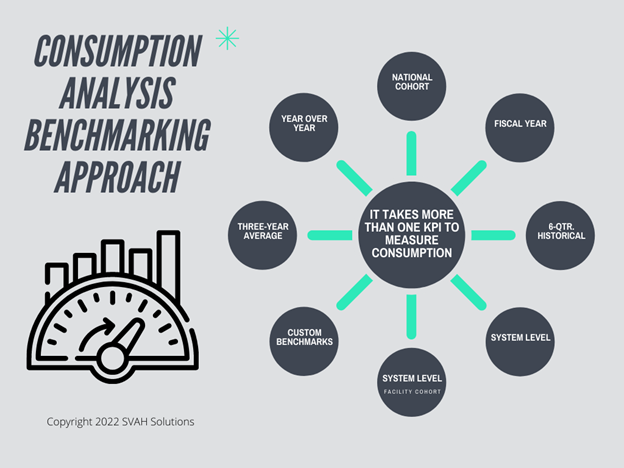
What we are hearing from our supply chain community is that their GPOs are still managing their price at the pump adequately but have limited tools to manage a healthcare organization’s consumption/utilization of the products, services, and technologies they are buying.
This missing capability from your GPOs is mission critical for your hospital, system, or IDN’s survival since consumption/utilization management is where most of the new non-salary savings are available to you now. To get you started on this journey, here are eight key performance indicators (KPIs) that are required to measure where you stand today on any and all commodity groups related to consumption/utilization:
1. National Cohort: One of the keys to benchmarking excellence is to compare apples to apples when measuring your commodities’ consumption/utilization. That’s why you need a methodology to compare your hospital, department, or unit’s commodity metrics to a cohort with like demographics.
2. Fiscal Year: Measuring any change during a fiscal year will give you an insight into what needs to be analyzed. For example, if your IV set consumption has doubled in one fiscal year, this is a good target of opportunity.
3. Six Quarter Historical: A six quarter measurement gives you another dimension over a longer period of time to gauge whether there are opportunities for improvement.
4. System Level: This metric will help you discover your best and worst performers in a commodity group. This is key to developing your own organization’s supply chain expense best practices. For example, if an operating room is seven percent lower in suture consumption than other operating rooms in your system, you need to know what they are doing differently. Most likely, this is a best practice that can be shared with your other hospitals.
5. System Level (by Facility Cohort): Hospitals can also measure their own monthly/quarterly/yearly best practice levels to ascertain waste and inefficiencies in their department or unit’s consumption. But remember, you need to measure these metrics by cohort or you won’t be comparing apples to apples.
6. Custom Benchmarks: At times, hospitals, departments, or units are so unique that you need to customize their benchmarks. This could mean going beyond your own cohort to find matches that involve more than one department or unit’s metrics.
7. Three-Year Average: A three-year average gives you a look back over the last three years to see what has changed. You would be surprised at what you will discover.
8. Year-Over-Year: This metric should be one of the easiest to obtain since it only requires comparing one year to another.
Why should these consumption analysis benchmarks be important to you? Because more and more hospitals, systems, and IDNs are refocusing their efforts on cost management now that more red ink is showing up on their financials. That’s why it’s important for supply chain professionals to contribute to reducing their healthcare organization’s non-salary cost to keep your hospital, system, or IDN afloat. A good starting point, as we already said, is for you to understand where you stand today!
P.S. If you would like a FREE Consumption Analysis (valued at $5,800) to determine your consumption/utilization savings opportunity, please contact us at ryokl@SVAHSolutions.com for more information. Generally, the savings is in the range of 7% to 15% of your supply chain budget.
Below are some similar articles that you may find interesting.
Healthcare Supply Chain Management: 3 Ways To Lose Money With Rebates
3 Tips About Value Analysis Committees Vs. VA Teams You Can’t Afford To Miss
3 Ways To Increase Your Supply Chain Expense Savings Without Help From GPOs
